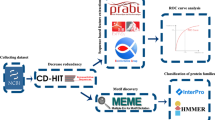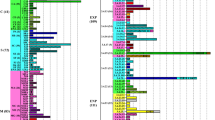Abstract
A total of 129 proteases sequences comprising 43 serine proteases, 36 aspartic proteases, 24 cysteine protease, 21 metalloproteases, and 05 neutral proteases from different Aspergillus species were analyzed for the catalytically active site residues using MEROPS database and various bioinformatics tools. Different proteases have predominance of variable active site residues. In case of 24 cysteine proteases of Aspergilli, the predominant active site residues observed were Gln193, Cys199, His364, Asn384 while for 43 serine proteases, the active site residues namely Asp164, His193, Asn284, Ser349 and Asp325, His357, Asn454, Ser519 were frequently observed. The analysis of 21 metalloproteases of Aspergilli revealed Glu298 and Glu388, Tyr476 as predominant active site residues. In general, Aspergilli species-specific active site residues were observed for different types of protease sequences analyzed. The phylogenetic analysis of these 129 proteases sequences revealed 14 different clans representing different types of proteases with diverse active site residues.

Similar content being viewed by others
References
Rawlings, N. D., & Barrett, A. J. (1999). MEROPS: the peptidase database. Nucleic Acids Research, 27(1), 325–331.
Morya, V. K., Yadav, S., Kim, E. K., & Yadav, D. (2012). In silico characterization of alkaline proteases from different species of Aspergillus. Applied Biochemistry and Biotechnology, 166(1), 243–257.
Rawlings, N. D., Morton, F. R., & Barrett, A. J. (2007). In A. P. MacCabe & J. Polaina (Eds.), Industrial enzymes structure, function and applications (pp. 161–180). The Netherlands: Springer.
Rawlings, N. D., Barrett, A. J., & Bateman, A. (2010). MEROPS: the peptidase database. Nucleic Acids Research, 38, D227–D233.
Polgar, L. (2004). Catalytic mechanisms of serine and threonine peptidases. In A. J. Barrett, N. D. Rawlings, & J. F. Woessner (Eds.), Handbook of Proteolytic Enzymes (pp. 1440–1448). London: Elsevier.
James, M. N. G. (2004). Catalytic pathway of aspartic peptidases. In A. J. Barrett, N. D. Rawlings, & J. F. Woessner (Eds.), Handbook of proteolytic enzymes (pp. 12–19). London: Elsevier.
Auld, D. (2004). Catalytic mechanisms of metallopeptidases. In A. J. Barrett, N. D. Rawlings, & J. F. Woessner (Eds.), Handbook of proteolytic enzymes (pp. 268–289). London: Elsevier.
Gutteridge, A., Bartlett, G. J., & Thornton, J. M. (2003). Using a neural network and spatial clustering to predict the location of active sites in enzymes. Journal of Molecular Biology, 330, 719–734.
Shapiro, L., & Harris, T. (2000). Finding function through structural genomics. Current Opinion in Biotechnology, 11, 31–35.
Ofran, Y., Punta, M., Schneider, R., & Rost, B. (2005). Beyond annotation transfer by homology: novel protein-function prediction methods to assist drug discovery. Drug Discovery Today, 10, 1475–1482.
Bartlett, G. J., Porter, C. T., Borkakoti, N., & Thornton, J. M. (2002). Analysis of catalytic residues in enzyme active sites. Journal of Molecular Biology, 324, 105–121.
Chou, K. C., & Cai, Y. D. (2004). A novel approach to predict active sites of enzyme molecules. Proteins, 55, 77–82.
Todd, A. E., Orengo, C. A., & Thornton, J. M. (2001). Evolution of function in protein superfamilies, from a structural perspective. Journal of Molecular Biology, 307, 1113–1143.
Rost, B. (2002). Crystal structure of cleaved human α1-antichymotrypsin at 2.7 å resolution and its comparison with other serpins. Journal of Molecular Biology, 318, 595–608.
Tian, W., & Skolnick, J. (2003). How well is enzyme function conserved as a function of pairwise sequence identity? Journal of Molecular Biology, 333, 863–882.
Orengo, C. A., Todd, A. E., & Thornton, J. M. (1999). From protein structure to function. Current Opinion in Structural Biology, 9, 374–382.
Porter, C. T., Bartlett, G. J., & Thornton, J. M. (2004). The catalytic site atlas: a resource of catalytic sites and residues identified in enzymes using structural data. Nucleic Acids Research, 32, D129–D133.
Torrance, J. W., Bartlett, G. J., Porter, C. T., & Thornton, J. M. (2005). Using a library of structural templates to recognise catalytic sites and explore their evolution in homologous families. Journal of Molecular Biology, 347, 565–581.
Zhang, Z., & Grigorov, M. (2006). Similarity networks of protein binding sites. Proteins Structure Function Genet, 62(2), 470–478.
Zhang, Z., & Tang, Y. R. (2007). Genome-wide analysis of enzyme structure-function combination across three domains of life. Protein and Peptide Letters, 14, 291–297.
Yadav, P. K., Singh, V. K., Yadav, S., Yadav, K. D. S., & Yadav, D. (2009). In silico analysis of pectin lyases and pectinases based on protein sequences. Biochemistry (Moscow), 74, 1049–1055.
Rao, M. B., Tanksale, A. M., Ghatge, M. S., & Deshpande, V. V. (1998). Molecular and biotechnological aspects of microbial proteases. Microbiology and Molecular Biology Reviews, 62, 597–635.
Tamura, K., Dudley, J., Nei, M., & Kumar, S. (2007). MEGA4: Molecular Evolutionary Genetics Analysis (MEGA) software version 4.0. Molecular Biology and Evolution, 24, 1596–1599.
Rawlings, N. D., & Barrett, A. J. (1993). Evolutionary families of peptidases. Biochemical Journal, 290, 205–218.
Kato, I., Schrode, J., Kohr, W. J., & Laskowski, M. J. (1987). Chicken ovomucoid: determination of its amino acid sequence, determination of the trypsin reactive site, and preparation of all three of its domains. Biochemistry, 26, 193–201.
Laskar, A., Rodger, E. J., Chatterjee, A., & Mandal, C. (2012). Modeling and structural analysis of PA clan serine proteases. BMC Res Notes, 24(5), 256. doi:10.1186/1756-0500-5-256.
Coates, L., Tuan, H. F., Tomanicek, S., Kovalevsky, A., Mustyakimov, M., Erskine, P., & Cooper, J. (2008). The catalytic mechanism of an aspartic proteinase explored with neutron and X-ray diffraction. Journal of the American Chemical Society, 130, 7235–7237.
Robbins, A. H., Dunn, B. M., Agbandje-McKenna, M., & McKenna, R. (2009). Crystallographic evidence for noncoplanar catalytic aspartic acids in plasmepsin II resides in the Protein Data Bank. Acta Crystallographica Section D: Biological Crystallography, 65, 294–296.
Zou, Z., Lopez, D. L., Kanost, M. R., Evans, J. D., & Jiang, H. (2006). Comparative analysis of serine protease-related genes in the honey bee genome: possible involvement in embryonic development and innate immunity. Insect Molecular Biology, 15(5), 603–614.
Acknowledgments
Authors VKM acknowledge the Inha University, Republic of Korea for providing the required assets and environment. Author SY and DY acknowledge the DDU Gorakhpur University Gorakhpur.
Author information
Authors and Affiliations
Corresponding author
Rights and permissions
About this article
Cite this article
Morya, V.K., Yadav, V.K., Yadav, S. et al. Active Site Characterization of Proteases Sequences from Different Species of Aspergillus . Cell Biochem Biophys 74, 327–335 (2016). https://doi.org/10.1007/s12013-016-0750-9
Received:
Accepted:
Published:
Issue Date:
DOI: https://doi.org/10.1007/s12013-016-0750-9




